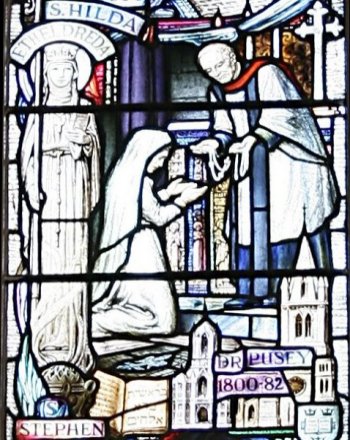
The third row of panels in the left and right lights depicts scenes from the Catholic revival of the Church of England in the 19th and early 20th centuries. In the left light shown here we see Dr Edward Pusey, in surplice and stole, in front of the altar of St Mary's Church, Oxford, in 1841. Kneeling before him is Marian Hughes, making her vows of poverty, chastity and obedience as the first profesed Religious in the Church of England since the Reformation. (The University Church of St Mary, with the coat of arms of the University of Oxford, is depicted in the bottom right of this scene.) Standing on the left is the queenly figure of St Etheldreda (636-679), another significant figure from the history of Saxon Britain. Maynard preached about Dr Pusey and the restoration of the religious life on October 17, 1948.
The figure of Etheldreda is relevant to this depiction of the taking of vows by a more recent female Religious. Etheldreda was born in Suffolk around 636 and was brought up in an atmosphere of piety. St Hilda of Whitby, pictured in the panel above this, was her aunt, and Etheldreda cherished an ambition to become a nun. For political reasons, however, she was given in marriage, against her will, to King Tondbert of an East Anglian sub-kingdom. As part of her marriage settlement, she was given an estate that was later to become Ely. After the deaths of her husband and her father, she settled in religious retirement on her estate. However, politics intervened again, and she married Egfrith, the young second son of Oswiu, King of Northumbria. In 670, Egfrith became King himself. Etheldreda did not want to live with him as his wife, so she took refuge on her own lands at Ely. Here, in 673, Etheldreda built a large double monastery of which she became abbess, and she was widely respected for her wisdom and piety. Etheldreda died in 679, and many stories of miracles surround her memory. The abbey of Ely was constituted a cathedral in 1109.